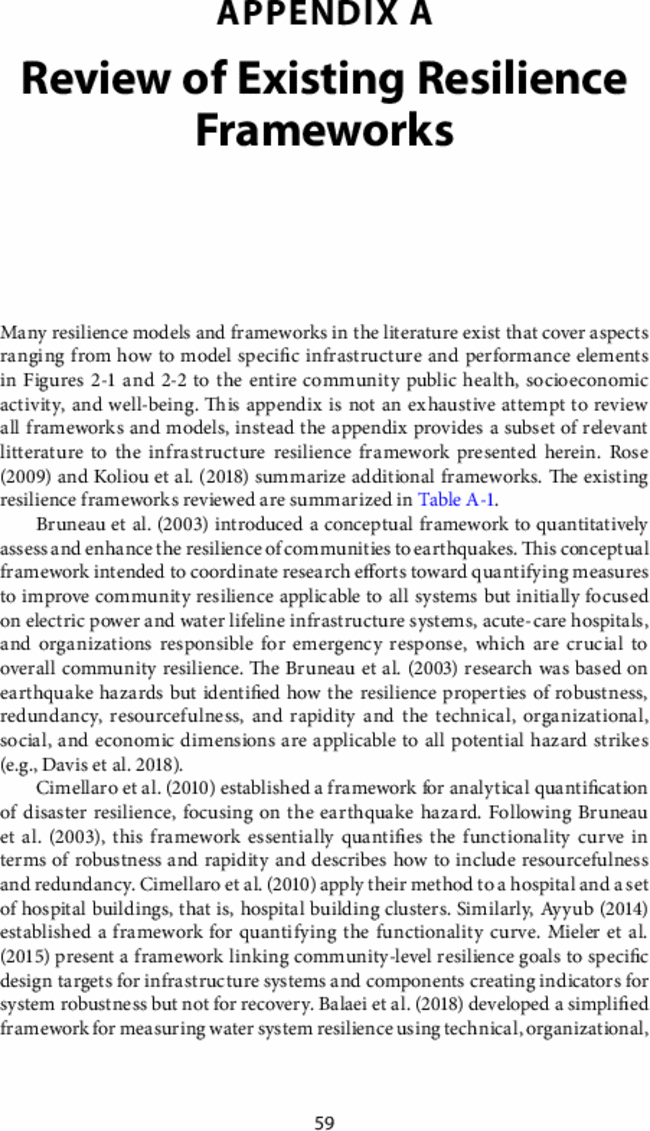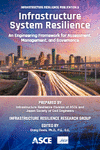Appendix A
Review of Existing Resilience Frameworks
Publication: Infrastructure System Resilience: An Engineering Framework for Assessment, Management, and Governance

Get full access to this article
View all available purchase options and get full access to this chapter.
References
AWWA (American Water Works Association). 2010. Risk and resilience management of water and wastewater systems. ANSI/AWWA J100-10. Denver: AWWA.
Ayyub, B. M. 2014. “Systems resilience for multihazard environments: Definition, metrics, and valuation for decision making.” Risk Anal. 34 (2): 340–355.
Balaei, B., S. Wilkinson, R. Potangaroa, N. Hassani, et al. 2018. “Developing a framework for measuring water supply resilience.” Nat. Hazard. Rev. 19 (4): 04018013.
Brashear, J., and J. Jones. 2010. “Risk analysis and management for critical asset protection (RAMCAP Plus).” Part 2. Cross-cutting themes and technologies, in risk modeling and vulnerability assessment.” In Wiley handbook of science and technology for homeland security, edited by J. G. Voeller. Hoboken, NJ: Wiley.
Bruneau, M., S. E. Chang, R. T. Eguchi, G. C. Lee, et al. 2003. “A framework to quantitatively assess and enhance the seismic resilience of communities.” Earthquake Spectra 19: 733–752.
CEB (United Nations System Chief Executives Board for Coordination). 2018. “Adopting an analytical framework on risk and resilience: A proposal for more proactive, coordinated and effective United Nations action.” High Level Committee on Programs, Prepared by a task team led by the World Food Programme. Annex III, CEB/2017/6, endorsed November 2017. Accessed April 7, 2019. https://www.unsceb.org/content/analytical-framework-risk-and-resilience.
Cimellaro, G. P., A. M. Reinhorn, and M. Bruneau. 2010. “Seismic resilience of a hospital system.” Struct. Infrastruct. Eng. 6 (1–2): 127–144.
Cutter, S. L., L. Barnes, M. Berry, C. Burton, et al. 2008. “A place-based model for understanding community resilience to natural disasters.” Global Environ. Change 18 (4): 598–606.
Davis, C., B. Ayyub, S. McNeil, K. Kobayashi, et al. 2022. “Infrastructure resilience: A framework for assessment, governance and management.” In Proc., 4th Global Summit of Research Institutes for Disaster Risk Reduction, Increasing the Effectiveness and Relevance of Our Institutes, 127–155. Singapore: Springer. Accessed March 19, 2023. https://www.springerprofessional.de/en/proceedings-of-the-4th-global-summit-of-research-institutes-for-/23775482.
Davis, C. A., A. Mostafavi, and H. Wang. 2018. “Establishing characteristics to operationalize resilience for lifeline systems.” Nat. Hazard. Rev. 19 (4): 04018014-1-21.
EPA (US Environmental Protection Agency). 2019. Vulnerability assessment tool. Version 2.0. Washington, DC: EPA.
Koliou, M., J. W. van de Lindt, T. P. McAllister, B. R. Ellingwood, et al. 2018. “State of the research in community resilience: Progress and challenges.” Sustainable Resilient Infrastruct. 5 (3): 131–151.
Links, J. M., B. S. Schwartz, S. Lin, N. Kanarek, et al. 2018. “COPEWELL: A conceptual framework and system dynamics model for predicting community functioning and resilience after disasters.” Disaster Med. Public Health Prep. 12 (1): 127–137.
Loggins, R., R. G. Little, J. Mitchell, T. Sharkey, et al. 2019. “CRISIS: Modeling the restoration of interdependent civil and social infrastructure systems following an extreme event.” Nat. Hazard. Rev. 20 (3): 04019004-1-21.
Mieler, M., B. Stojadinovic, R. Budnitz, M. Comerio, et al. 2015. “A framework for linking community-resilience goals to specific performance targets for the built environment.” Earthquake Spectra 31 (3): 1267–1283.
NASEM (National Academies of Sciences, Engineering, and Medicine). 2019. Building and measuring community resilience: Actions for communities and the Gulf Research Program. Washington, DC: National Academies Press.
NIST (National Institute of Standards and Technology). 2015. Community resilience planning guide for buildings and infrastructure systems. NIST Special Publication 1190. Gaithersburg, MD: NIST.
Renschler, C. S., A. E. Fraizer, L. A. Arendt, G. P. Cimellaro, et al. 2010. A framework for defining and measuring resilience at the community scale: The PEOPLES resilience framework. US Dept. of Commerce, NIST, Office of Applied Economics Engineering Laboratory NIST GCR 10-930. Gaithersburg, MD: NIST.
Rockefeller Foundation and ARUP. 2014. “City resilience framework.” Accessed March 10, 2019. https://www.rockefellerfoundation.org/report/city-resilience-framework/.
Rockefeller Foundation and ARUP. 2015. “City resilience index.” Accessed March 10, 2019. https://assets.rockefellerfoundation.org/app/uploads/20160201132303/CRI-Revised-Booklet1.pdf.
Rose, A. 2009. “Economic resilience to disasters.” Community and Regional Resilience Institute, CARRI Research Rep. 8, Published Articles and Papers, Paper 75. Accessed March 19, 2023. https://text2fa.ir/wp-content/uploads/Text2fa.ir-Economic-Resilience-to-Disasters-1.pdf.
United Nations. 2015. Transforming our world: The 2030 Agenda for Sustainable Development. A/RES/70/1. New York: United Nations.
United Nations. 2016. “The infrastructure–inequality–resilience nexus.” In Global sustainability development report. New York: United Nations.
UNISDR (United Nations Office for Disaster Risk Reduction). 2015. Sendai framework for disaster risk reduction 2015–2030. 1st ed. Geneva: United Nations.
Waage, J., C. Yap, S. Bell, C. Levy, et al. 2015. “Governing the UN Sustainable Development Goals: Interactions, infrastructures, and institutions.” Lancet Global Health 3 (5): E251–E252.
Information & Authors
Information
Published In
Infrastructure System Resilience: An Engineering Framework for Assessment, Management, and Governance
Pages: 59 - 67
Editor: Craig Davis, Ph.D., P.E., G.E.
ISBN (Online): 978-0-7844-8508-8
Copyright
© 2023 American Society of Civil Engineers.
History
Published online: Sep 25, 2023
Authors
Metrics & Citations
Metrics
Citations
Download citation
If you have the appropriate software installed, you can download article citation data to the citation manager of your choice. Simply select your manager software from the list below and click Download.
